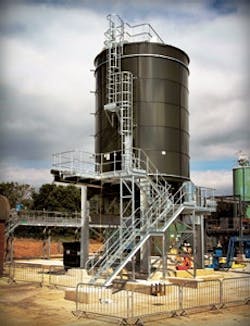About the author: Mark Neal is biosolids storage manager for Saxlund Intl. Ltd. Neal can be reached at [email protected] or +44(0) 2380 636330.
Instead of thinking of sludge as a cost center and something to be disposed of, many wastewater companies have come to realize that generating gas from sludge at large water treatment sites (hubs) and transporting sludge from smaller treatment works (satellites) to these larger hubs is the model of the future.
With the U.K.’s population predicted to reach 71 million by 2030, there is no shortage of sludge in England; such economy of scale already presents the opportunity to generate substantial amounts of biogas energy. More wastewater companies are building anaerobic digestion (AD) plants and thermal hydrolysis infrastructures near large cities and towns and creating smaller satellite stations in which to store their sludge prior to its transportation and feed into larger hubs.
Cutting Costs
Sludge can be dewatered into cake to reduce its bulk, thus minimizing transportation and storage costs. By dewatering sludge—for example, through centrifuge or belt press—slurry of circa 6% dry solids (DS) can be dewatered into cake comprising 22% DS. This represents a 4:1 reduction in volume, meaning that potentially one truck could be used instead of four for the equivalent mass without water. This reduction in volume can result in potential savings in storage and haulage costs of up to 75%.
The Right Choice of Transport
Transportation of sludge or sludge cake is an important factor in ensuring a trouble-free reception and delivery. Existing options include rigid and articulated trucks, or roll-on/roll-off (RO-RO) containers handling pumped or screw-fed cake at 22% DS; and articulated tankers for liquid sludge at approximately 6% DS. The cost savings of gas generating technology compared with transport of sludge (fuel) stock to hubs is largely determined by distance and load volumes from satellite sites. Typically, the savings are $14,000 to more than $24,000 per month for a 100-cu-meter truck loading silo compared with an existing two- to three-RO-RO container system. For a 240-cu-meter truck-loading silo, the savings are approximately $38,500 per month.
Truck-loading silos using sliding frame technology and screw conveyors enable great volumes of sludge to be handled in a short amount of time. Low-quality storage silos can result in problems with bridging and discharging.
Smart Engineering
Dewatering sludge into cake not only makes it easier to transport and store; it also helps to make it more friable, stable and safer to manage, while minimizing odor. Friable sludge, free from foreign objects, handled without excessive force and with an accurate dewatering sludge percentage, is what anaerobic digester operators require for optimum performance. A constant, precisely metered volumetric flow of friable sludge is critical to AD and thermal hydrolysis systems and requires properly engineered solutions that take account of the materials’ non-free-flowing properties to avoid the risk of blockages. A measured flow ensures a homogenous discharge to the next process.
The thermal hydrolysis process involves heating sludge to destroy any pathogens and degrading cell structures to create better flowing, quality sludge, making it easier for bacteria to digest and to produce methane. United Utilities and Anglian Water are two organizations successfully optimizing their sludge cake.
Anglian Water, the largest water and wastewater company in England and Wales, contracted Saxlund to deliver sludge cake handling and storage systems at 10 of its treatment facilities.
One of Saxlund’s earlier projects for Anglian Water was to develop and deliver a system for storage of sewage sludge cake at its Thetford satellite water treatment works in 2012.
A recent project included a truck reception and sludge cake silo at Anglian Water’s Whitlingham Water Recycling Centre in Norwich. This incorporated Saxlund’s sliding frame technology, where sludge is discharged via integrated sludge pumps into a process feed silo and then into a thermal hydrolysis process.
Today, 22% of the energy used by Anglian Water comes from renewable sources, such as biogas, solar and wind energy. Saxlund supports Anglian Water in its commitment to reshape its business around a low-carbon model.
These latest technological innovations are changing the way the wastewater industry deals with converting sewage sludge to energy. Robust bulk material handling solutions and advanced digestion systems are now commonplace in reducing fuel costs and carbon emissions while improving the efficient processing of wastewater and sewage sludge.
Download: Here
